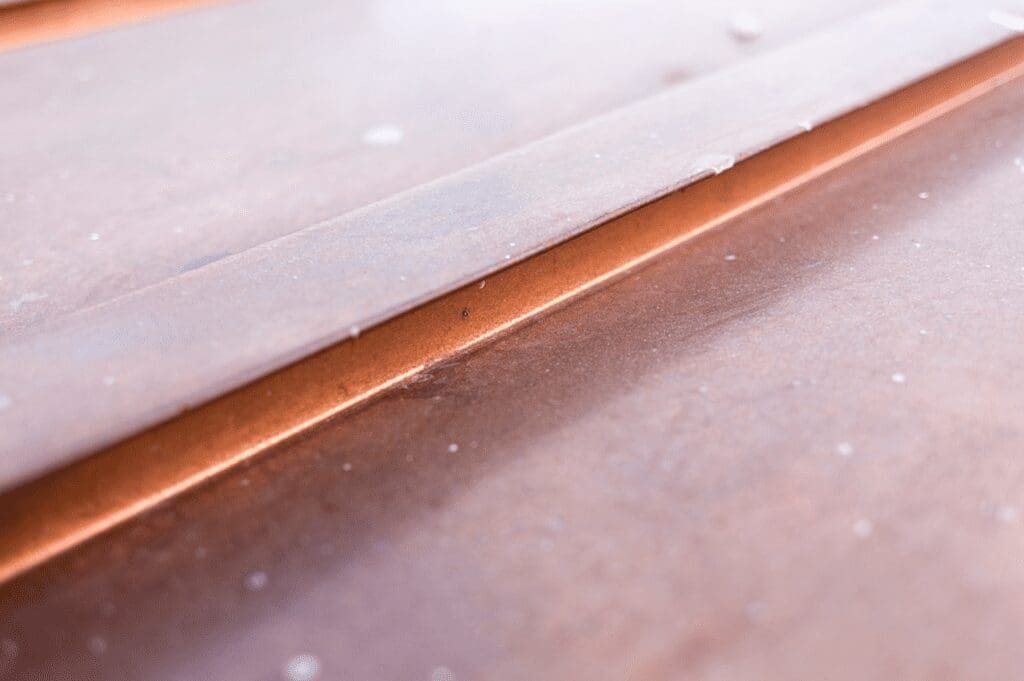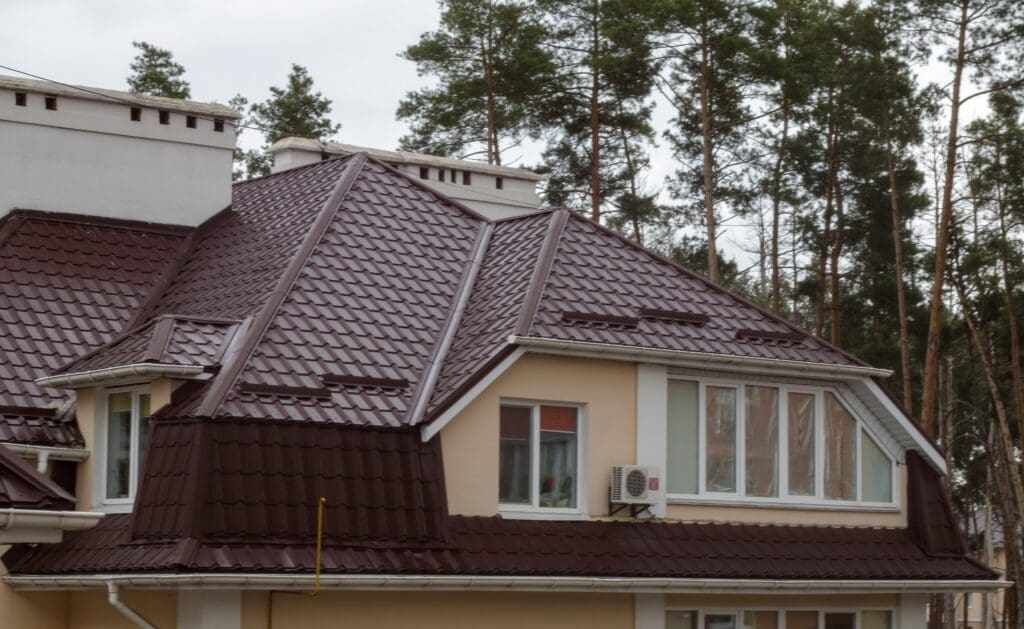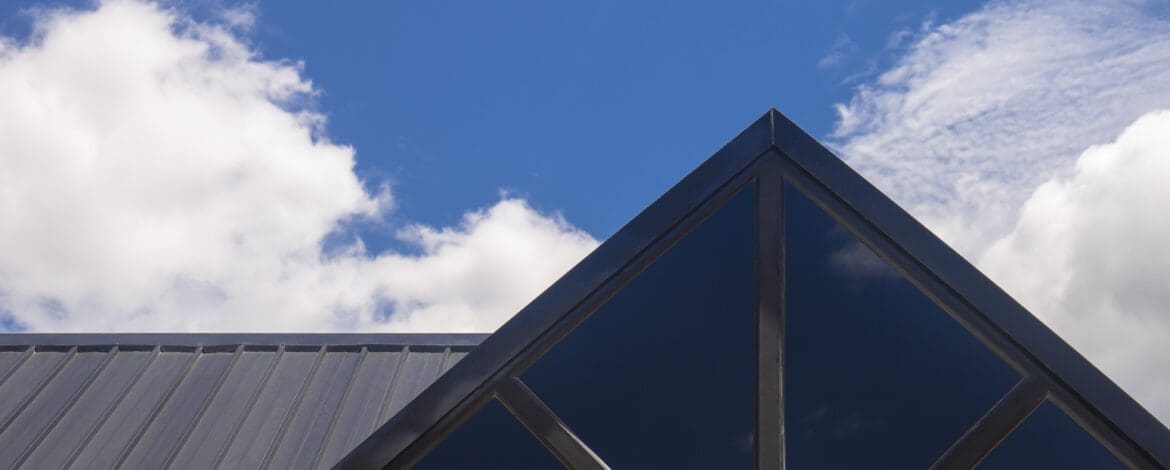Part 2: Metal Roofing
See Part 1 here.
First, metal roofing comes in a few distinct types. You’ll be faced with more options with metal roofing than with other roof types, and those options include the type of metal and the format of the roofing material. You can choose steel, aluminum, zinc, and copper for the material, and shingles and large panels for the format. Galvalume, also, is a steel roof panel that has an aluminum and zinc coating, making it sort of a hybrid material. It has proven to be a solid choice and offers an impressive warranty.
Another option is the type of fastener used. Sheets can be installed with exposed screws, which is the less-expensive option, and with concealed fasteners, which provide a cleaner look and far fewer exposed penetrations. Steel and aluminum shingles are a way to mimic a clay tile roof, and those tiles also will have concealed fasteners.
There is a massive range in cost to replace your roof for the different types of metal roofs. Just in steel alone, a standing-seam steel roof can be twice the cost of an exposed-fastener steel roof. A rule of thumb is that roofers charge two-thirds of the total cost for labor and overhead and one-third for materials. That guideline helps them cover the labor required for staging the site, installing drip edge, valleys, and the like. So while you might see a per-foot or per-square (100 square feet) cost, the installed cost is the only thing that matters.
What Material Do I Want?
Most metal roofs are steel because it’s cheaper and stronger than the other metals, and performs very well. All metal sheets or panels are available in quite long lengths, which means you may be able to have a seamless roof from top to bottom. Some contractors will use a machine that feeds the rolled metal through a press that creates the profile and produces the panels on site to the exact length needed, with no seams. That’s a good thing!
All types of metal roofing are also excellent at withstanding storms, high winds, and fire. Metal roofs will generally require minimal maintenance, such as periodically clearing leaves and other debris. Depending on where you live, washing it yearly may be recommended, as well. For the most part, though, just stay off of it unless you need to address something.
Steel Roofing
Steel roofing is used in the majority of projects because it’s strong, offers countless variations in color and profile, is the lowest-cost choice, and is durable. The downside to steel roofs, in contrast to aluminum, zinc, Galvalume, and copper, is the potential for corrosion. Steel roofs can rust, which usually occurs at cut edges and penetrations. This is more likely in humid climates like Florida’s than in arid climates, and especially in coastal areas. If a tree branch falls and penetrates the steel, there could be corrosion at that hole.
If you’re looking mostly at the total cost to replace your roof, rather than longevity, steel panels with exposed fasteners will give you the lowest price. Good news, though: you can get a 30+ year roof this way, which beats most asphalt-shingle roofs for about two to three times more installed cost. This is a very good roof, make no mistake.
Galvalume Roofing
A Galvalume roof is often compared to an aluminum roof. Again, Galvalume is made of steel panels with an aluminum and zinc coating. It can be supplied with a painted finish or left unpainted, which can save money versus a painted finish. A 25-year warranty is typical, except in coastal areas. Nonetheless, Galvalume offers significant corrosion protection and is stronger than aluminum. That matters, as heavy-duty storms and winds are becoming more intense and more frequent.
Aluminum Roofing
When your home is located in a coastal area, an aluminum roof should be one of the options. Why? Primarily because aluminum does not rust, so it can offer an extended lifespan, even though you may not get a warranty in a coastal area. Aluminum is more expensive than steel and Galvalume, and not as strong in resisting uplift from winds. There’s less demand for aluminum roofing, so you won’t find as many color options. However, it is an attractive roof that will last for decades.
Zinc Roofing
A zinc roof is a high-end choice that is used on about 70 percent of homes in Europe. It provides exceptional protection from the elements and is expected to last 80-plus years! The downside is the cost, with only copper costing more. Like copper, zinc develops a patina over time due to oxidation. The patina actually provides additional protection and can “heal” when scratched.
Copper

A copper roof looks like no other roof. It’s bold, beautiful, and pricey. It’s also extremely durable and can last more than 50 years. That’s a lifetime roof. As you might expect, it’s used for homes where the budget is not the top priority, as well as for commercial and institutional projects. Architects and designers choose copper for its striking color that morphs over time with the verdigris patina that develops naturally and creates a greenish hue on the surface.
So for these metal-roof options, what’s the cost to replace your roof ? Here’s where to start.
What About Fasteners?
Roofs are installed either with fasteners that you can see, or that are hidden by the design of the roof itself. Though roofing with exposed fasteners can be expected to last more than 25 years, roofs with concealed fasteners can double that. Yes, more than 50 years, so that might be a lifetime roof for you. That said, many people have a one-year or five-year window before moving from their current home and there’s no incentive to buy the lifetime roof. Opting for a basic metal roof makes sense for those folks.
Exposed-Fastener Systems

These roofs are commonly used and offer excellent value with the tradeoff of seeing the exposed screws through the face of the material. The screws have a rubber washer that seals the hole from rain. This type of roof can last more than 40 years when installed properly. They provide a Class A fire rating, which is the best rating. They’re also wind resistant, won’t rot, and don’t degrade from ultraviolet radiation. They’re a low-maintenance roof, but regular inspections and possibly tightening the screws periodically are a good idea.
True, some people think of them as “barn roofing” or “industrial roofing” as they’re frequently used on pole barns, horse barns, sheds, and warehouses. But you’ll have a massive variety of colors and different profiles to choose from.
As far as the profile stamped onto the steel panels, ribbed roofing has raised ribs with a flattened top, which is typically the location for the screws. Corrugated roofing is similar, but the profile is a continuous wave. These two options are installed in the same way. The price is low compared to all the advantages they offer, and getting a 40-year roof with excellent protection against both intense wind and storms, and top-notch fire protection, is a most attractive option. That could be a lifetime roof for many of us.
The major drawback is the fasteners. The screws are painted to match the roof color, so are not that visible from the ground, but they have a rubber washer that squishes a bit between the screw head and the panel to seal out water. If the installer under-tightens the screw, water can penetrate the panel and reach the roof decking. In Florida, that is a major problem. An installer can also over-tighten a screw, causing it to strip out in the hole. At that point, it’s not holding the panel down and the panel is more susceptible to uplift from winds. Again, not good. But many installers are accurate and get those screws in just right.
Concealed-Fastener Systems
This type of roof is often known as a standing-seam roof and is used with steel, Galvalume, aluminum, zinc, and copper panels. It requires a bit more skill and is more work for the contractor, as each panel requires more steps to install. The design is ingenious in using interlocking and overlapping panels with each panel covering the screws of the previously installed panel. The standing seams are formed so they lock together, and there’s no need for another fastener at that junction.
The installer has to trim and bend each piece at the eave line (the bottom edge of the roof), creating a “hem” that wraps around the drip edge and secures the bottom end of the panel. It’s simple, attractive, and durable. It resists wind uplift and does not wear out. Where panels meet at a gable or valley, or butt against a wall, or for penetrations, trim pieces are often available pre-formed. The installer just orders those pieces ready to use, which saves a lot of time on installation day.
A standing-seam roof really has few drawbacks. As we mentioned, you can choose steel, Galvalume, aluminum, zinc, or copper. Each will have a different level of strength and dent resistance. Any metal roof is lightweight so does not require any structural roof upgrades. It’s compatible with photovoltaic panels, it’s washable, and it’s environmentally responsible when you consider its 40-plus-year lifespan and recyclability. For most of us that’s a lifetime roof.
One aesthetic issue is “oil canning.” This phenomenon occurs on flat sheets of metal that develop a wavy form from heating and cooling. It does not affect the performance or durability of the panels, but it doesn’t look great. One solution is to add more raised ribs that break up the flat expanse of each panel. They can be quite subtle and don’t detract from the clean and simple appearance of a standing-seam roof.
Metal Shingle Roofing

If you don’t like the aesthetics of a standing-seam roof, or your HOA doesn’t permit them, you can consider a stamped metal shingle roof, which offers most of the advantages of a standing-seam roof with the traditional look of shingles, shakes, slate, or tiles. These roofs can be made of any metal, but most are steel. You can choose the finish color, which now includes subtle shading intended to mimic other materials like slate and wood shakes. As with other metal options, this is a lightweight roof that doesn’t require structural reinforcement. This type of roof uses interlocking panels and concealed fasteners.
We’re Here When You Need Us
If you’d like to talk about replacing your roof, give us a call at 813-373-9088. Our team has more than 40 years of experience in roofing. You can also use this form and ask us, “What’s the cost to replace my roof?” and we will contact you.
CLICK HERE FOR AN INSTANT ONLINE QUOTE IN 60 SECONDS
clear


